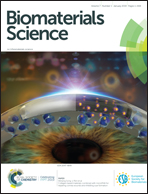Differentiating human pluripotent stem cells into vascular smooth muscle cells in three dimensional thermoreversible hydrogels†
Abstract
Vascular smooth muscle cells (VSMCs) are of great value and are needed in large quantities for tissue engineering, drug screening, disease modeling and cell-based therapies. However, getting high quantity VSMCs remains a challenge. Here, we report a method for the scalable manufacturing of VSMCs from human pluripotent stem cells (hPSCs). hPSCs are expanded and differentiated into VSMCs in a three dimensional (3D) thermoreversible hydrogel. The hydrogel not only acts as a 3D scaffold for cells to grow, but also protects cells from hydrodynamic stresses in the culture vessel and prevents cells from excessive aggregation. Together, the hydrogel creates a cell-friendly microenvironment, leading to high culture efficiency. We show that VSMCs can be generated in 10 days with high viability (>90%), high purity (>80%) and high yield (∼2.0 × 107 cells per mL hydrogel) in the hydrogel scaffold. The generated VSMCs have normal functions. Genome-wide gene expression analysis shows VSMCs made in the hydrogel (i.e. 3D-VSMCs) have higher expression of genes related to vasculature development and glycolysis compared to VSMCs made in the conventional 2D cultures (i.e. 2D-VSMCs), while 2D-VSMCs have higher expression of genes related to cell proliferation. This simple, defined and efficient method is scalable for manufacturing hPSC-VSMCs for various biomedical applications.



 Please wait while we load your content...
Please wait while we load your content...